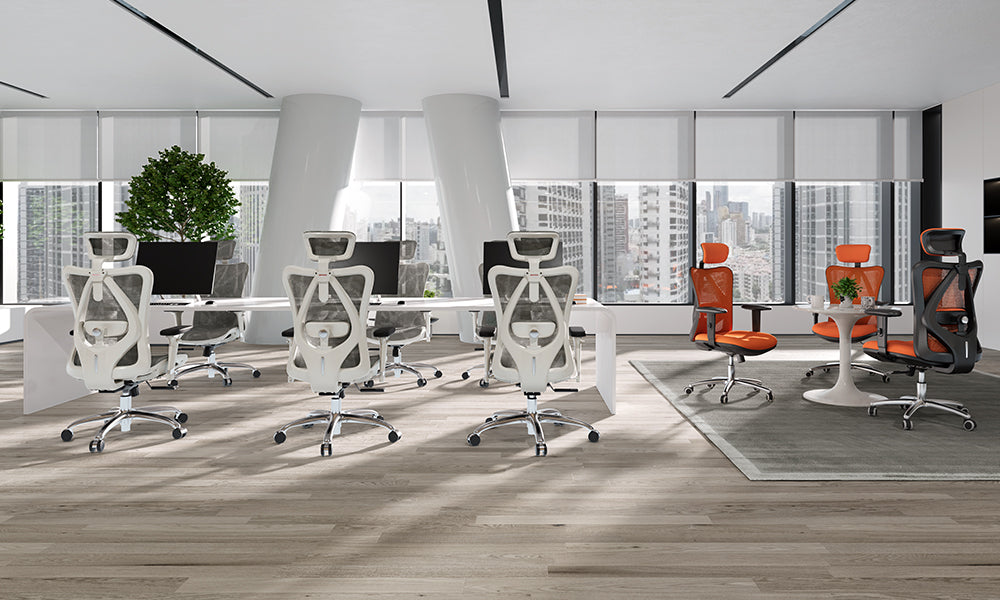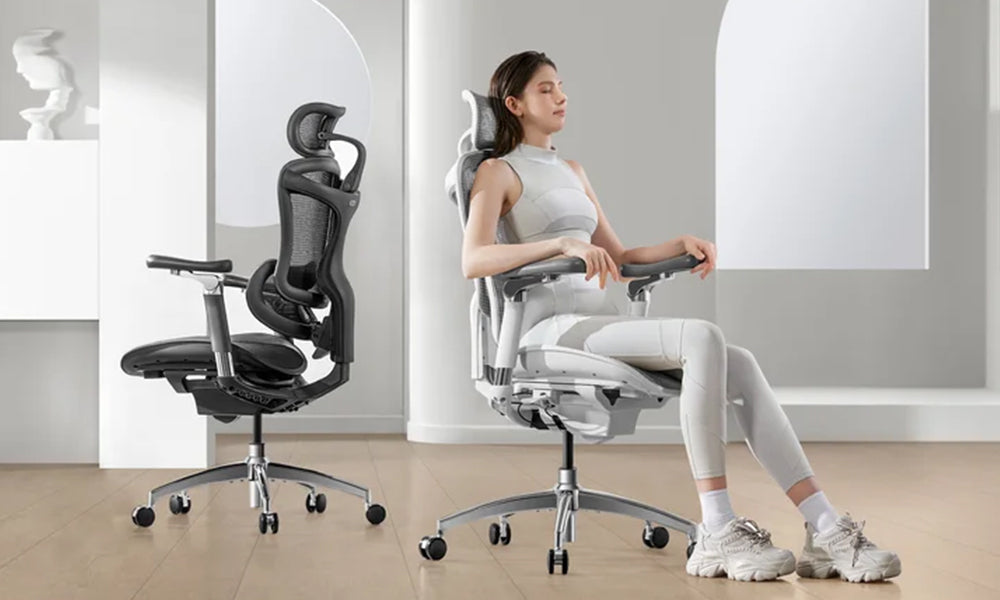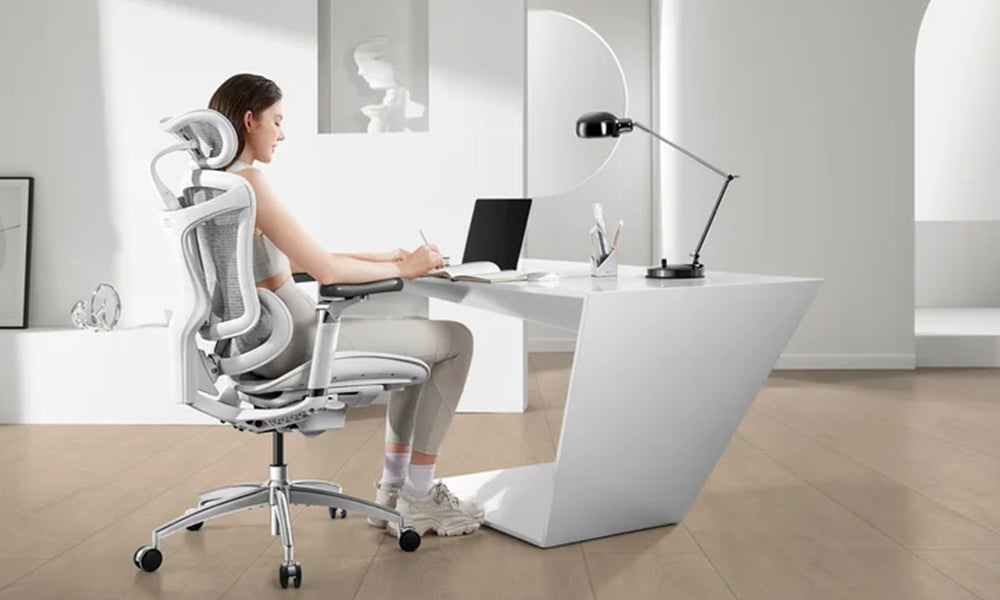An ergonomic chair is a chair that is designed to fit the user's body, preference, and activity, providing optimal comfort and support. An ergonomic chair can have various features and adjustments, such as height, width, depth, angle, tilt, and shape, that allow the user to customize the chair to their needs and preferences. An ergonomic chair can also have various accessories and components, such as lumbar support, headrest, armrests, and casters, that enhance the functionality and usability of the chair.
One of the most important aspects of an ergonomic chair is the upholstery, or the material that covers the seat and the backrest. The upholstery can affect the comfort, durability, and appearance of the chair, as well as the user's health and productivity. Therefore, choosing the right upholstery for your ergonomic chair is a crucial decision that requires careful consideration and comparison.
There are three main types of upholstery for ergonomic chairs: mesh, fabric, and leather. Each type has its own advantages and disadvantages, depending on the user's needs and preferences. In this article, we will compare and contrast these three types of upholstery and help you to choose the right one for your ergonomic chair.
Mesh
Mesh is a type of upholstery that is made of woven or knitted fibers, such as nylon, polyester, or cotton. Mesh is a popular choice for ergonomic chairs, especially for those who work in hot and humid environments, as it has the following advantages:
• Breathability: Mesh is a breathable material that allows air to circulate through the seat and the backrest, keeping the user cool and dry. Mesh can also prevent the user from sweating and sticking to the chair, which can cause discomfort and hygiene issues.
• Flexibility: Mesh is a flexible material that can conform to the user's body shape and weight, providing optimal support and comfort. Mesh can also adapt to the user's movements, allowing the user to change positions and postures easily and smoothly.
• Durability: Mesh is a durable material that can resist wear and tear, as well as stains and spills. Mesh can also maintain its shape and color for a long time, without sagging or fading.
However, mesh also has some disadvantages, such as:
• Firmness: Mesh is a firm material that can feel hard and stiff, especially for those who prefer a softer and cushier seat and backrest. Mesh can also cause pressure points and discomfort on the user's skin, especially on the thighs and the lower back.
• Maintenance: Mesh is a difficult material to clean and maintain, as it can trap dust and dirt in its fibers, which can be hard to remove. Mesh can also snag and tear easily, especially if it comes in contact with sharp objects or rough surfaces.
Fabric
Fabric is a type of upholstery that is made of woven or knitted threads, such as wool, cotton, or polyester. Fabric is a common choice for ergonomic chairs, especially for those who work in cold and dry environments, as it has the following advantages:
• Softness: Fabric is a soft material that can feel cozy and comfortable, especially for those who prefer a plush and cushiony seat and backrest. Fabric can also provide warmth and insulation, keeping the user warm and cozy.
• Variety: Fabric is a versatile material that can come in various colors, patterns, textures, and styles, allowing the user to choose the one that suits their preference and style. Fabric can also create a more casual and friendly atmosphere, which can improve the user's mood and productivity.
• Affordability: Fabric is an affordable material that can fit any budget, as it is cheaper and more readily available than other types of upholstery. Fabric can also be easily replaced or repaired, if it gets damaged or worn out.
However, fabric also has some disadvantages, such as:
• Absorbency: Fabric is an absorbent material that can soak up moisture, such as sweat, spills, or humidity, which can cause discomfort and hygiene issues. Fabric can also harbor bacteria, fungi, and allergens, which can cause health problems, such as allergies, infections, and asthma.
• Fading: Fabric is a fading material that can lose its color and brightness over time, due to exposure to sunlight, heat, or chemicals. Fabric can also stain and discolor easily, especially if it comes in contact with liquids or dirt.
Leather
Leather is a type of upholstery that is made of animal skin, such as cowhide, sheepskin, or pigskin. Leather is a premium choice for ergonomic chairs, especially for those who work in formal and professional environments, as it has the following advantages:
• Elegance: Leather is an elegant material that can create a sophisticated and luxurious look, especially for those who prefer a classic and refined style. Leather can also enhance the user's confidence and self-esteem, as well as the user's impression on their clients and colleagues, as well as their performance and productivity.
• Durability: Leather is a durable material that can last for a long time, without cracking, peeling, or fading. Leather can also resist wear and tear, as well as stains and spills, as it has a smooth and waterproof surface that can be easily wiped and cleaned.
• Comfort: Leather is a comfortable material that can adapt to the user's body temperature and humidity, providing optimal comfort and support. Leather can also mold to the user's body shape and weight, providing optimal support and comfort.
However, leather also has some disadvantages, such as:
• Cost: Leather is a costly material that can be expensive and unaffordable, as it is rare and scarce. Leather can also be difficult and costly to replace or repair, if it gets damaged or worn out.
• Maintenance: Leather is a sensitive material that requires special care and maintenance, as it can be damaged by exposure to sunlight, heat, or chemicals. Leather can also dry out and crack, if it is not moisturized and conditioned regularly.
• Allergies: Leather is an allergenic material that can cause allergic reactions, such as rashes, itching, or swelling, especially for those who have sensitive skin or are allergic to animal products. Leather can also trigger asthma attacks, as it can release volatile organic compounds, or VOCs, that can irritate the respiratory system.
These are the three main types of upholstery for ergonomic chairs: mesh, fabric, and leather. Each type has its own advantages and disadvantages, depending on the user's needs and preferences. You can compare and contrast these types and choose the one that suits you best. You can also consult an ergonomic expert or a health professional for advice and guidance on how to choose and use your ergonomic office chair with the right upholstery properly and effectively.



